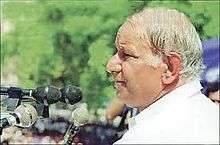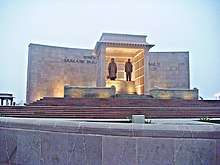Kanshi Ram
'Kanshi Ram (15 March 1934 – 9 October 2006), also known as ', Bahujan Nayak[1] or Saheb,[2] was an Indian politician and social reformer who worked for the upliftment and political mobilisation of the Bahujans, the backward or lower caste people including untouchable groups at the bottom of the caste system in India.[3] Towards this end, Kanshi Ram founded Dalit Shoshit Samaj Sangharsh Samiti (DS-4), the All India Backward and Minority Communities Employees' Federation (BAMCEF) in 1971 and the Bahujan Samaj Party (BSP) in 1984. He ceded leadership of the BSP to his protégé Mayawati who has served four terms as Chief Minister of Uttar Pradesh.
Kanshi Ram | |
|---|---|
 | |
| National president of the Bahujan Samaj Party | |
| In office 14 April 1984 – 18 September 2003 | |
| Succeeded by | Mayawati |
| Member of the Indian Parliament for Hoshiarpur | |
| In office 1996–1998 | |
| Preceded by | Kamal Chaudhry |
| Succeeded by | Kamal Chaudhry |
| Member of the Indian Parliament for Etawah | |
| In office 1991–1996 | |
| Preceded by | Ram Singh Shakya |
| Succeeded by | Ram Singh Shakya |
| Personal details | |
| Born | 15 March 1934 Rupnagar district, Punjab Province, British India |
| Died | 9 October 2006 (aged 72) New Delhi, India |
| Political party | Bahujan Samaj Party |
| Website | www |
Early life
Kanshi Ram was born to a Chamar family, on 15 March 1934 in Ropar district, Punjab, British India. Some sources say his birthplace was the village of Pirthipur Bunga[4] and others that it was Khawaspur village. His family were born in the Chamar or Ravidassia community.
After studies at various local schools,[5] Ram graduated in 1956 with a BSc degree from Government College Ropar.[6]
Career
Kanshi Ram joined the offices of the Explosive Research and Development Laboratory in Pune[7] under the government's scheme of affirmative action. It was at this time that he first experienced caste discrimination[6] and in 1964 he became an activist. Those who admire him claim that he was spurred to this after reading B. R. Ambedkar's book Annihilation of Caste and witnessing what he perceived to be discrimination against a Dalit employee who wished to observe a holiday celebrating Ambedkar's birth. Kanshi Ram strongly inspired by B. R. Ambedkar and his philosophy.[8]
Ram initially supported the Republican Party of India (RPI) but became disillusioned with its co-operation with the Indian National Congress. In 1971, he founded the All India SC, ST, OBC and Minority Employees Association and in 1978 this became BAMCEF, an organisation that aimed to persuade educated members of the Scheduled Castes, Scheduled Tribes, Other Backwards Classes and Minorities to support Ambedkarite principles. BAMCEF was neither a political nor a religious body and it also had no aims to agitate for its purpose. Suryakant Waghmore says it appealed to "the class among the Dalits that was comparatively well-off, mostly based in urban areas and small towns working as government servants and partially alienated from their untouchable identities".[9]
Later, in 1981, Ram formed another social organisation known as Dalit Shoshit Samaj Sangharsh Samiti (DSSSS, or DS4). He started his attempt of consolidating the Dalit vote and in 1984 he founded the Bahujan Samaj Party (BSP). He fought his first election in 1984 from Janjgir-Champa seat in Chhattisgarh.[10] The BSP found success in Uttar Pradesh, initially struggled to bridge the divide between Dalits and Other Backward Classes[11] but later under leadership of Mayawati bridged this gap.[12]
In 1982 he wrote his book The Chamcha Age, in which he used the term chamcha (stooge) to describe Dalit leaders such as Jagjivan Ram and Ram Vilas Paswan.[7] He argued that Dalits should work politically for their own ends rather than compromise by working with other parties.[13]
After forming BSP Ram said the party would fight first election to lose, next to get noticed and the third election to win.[14] In 1988 he contested Allahabad seat up against a future Prime Minister V. P. Singh and performed impressively but lost polling close to 70,000 votes.[15]
He unsuccessfully contested from East Delhi (Lok Sabha constituency) in 1989 and came at fourth position. Then he represented the 11th Lok Sabha from Hoshiarpur,[16] Kanshiram was also elected as member of Lok Sabha from Etawah in Uttar Pradesh. In 2001 he publicly announced Mayawati as his successor.
In the late 1990s, Ram described the BJP as the most corrupt (mahabrasht) party in India and the INC, Samajwadi Party and Janata Dal as equally corrupt.[17][18]
Proposed conversion to Buddhism
In 2002, Ram announced his intention to convert to Buddhism on 14 October 2006, the 50th anniversary of Ambedkar's conversion. He intended for 50,000,000 of his supporters to convert at the same time. Part of the significance of this plan was that Ram's followers include not only untouchables, but persons from a variety of castes, who could significantly broaden Buddhism's support. However, he died on 9 October 2006.[19]
Mayawati his successor said "Saheb Kanshi Ram and I had decided that we will convert and adopt Buddhism when we will get "absolute majority" at the Centre. We wanted to do this because we can make a difference to the religion by taking along with us millions of people. If we convert without power then only we two will be converting. But when you have power you can really create a stir".[20]
Death
Ram was a diabetic. He suffered a heart attack in 1994, an arterial clot in his brain in 1995, and a paralytic stroke in 2003.[21] He died in New Delhi on 9 October 2006 of a severe heart attack at the age of 72.[22] He had been virtually bed-ridden for more than two years.[23] According to his wishes,[24] his funeral rites were performed according to Buddhist tradition, with Mayawati lighting the pyre.[21] His ashes were placed in an urn and kept at Prerna Sthal, where many people paid their respects.[25]
In his condolence message, Indian Prime Minister Manmohan Singh described Ram as "one of the greatest social reformers of our time .. his political ideas and movements had a significant impact on our political evolution ... He had a larger understanding of social change and was able to unite various underprivileged sections of our society and provide a political platform where their voices would be heard." Under Ram's leadership, the BSP won 14 parliamentary seats in the 1999 federal elections.[26]
Books
In 1982, Ram wrote The Chamcha Age (The Era of the Stooges), a book in which he used the term chamcha (stooge) for Dalit leaders whom he alleged had selfish reasons to work for parties such as the Indian National Congress (INC)[7] and Bharatiya Janata Party (BJP).[13] His book Birth of BAMCEF was also published.[27] His biography, Kanshiram: Leader Of The Dalits was written by Badri Narayan Tiwari.[28][29] His speeches are compiled in books like Bahujan Nayak Kanshiram Ke Avismarniya Bhashan by Anuj Kumar, Writings & Speeches of Kanshiram compiled by S. S. Gautam and The Editorials of Kanshi Ram by Bahujan Samaj Publications in 1997.
Legacy

There are many government programmes and schemes[30][31] and public institutions named after Kanshi Ram in Uttar Pradesh.[32][33][34][35] His birthplace Pirthipur Bunga Sahib has a memorial with his statue.[36] Manyawar Shri Kanshiram Ji Green Eco Garden in Lucknow has been named in his memory.[37]
References
- "Kanshi Ram should be given the Bharat Ratna: Mayawati". DNA. 15 March 2016. Retrieved 24 April 2016.
- Singh, Rajesh Kumar (30 July 2015). "This bard wants Kanshi Ram loyalists to spread wings". Hindustan Times. Retrieved 16 October 2016.
- Narayan, Badri (11 May 2012). "Ambedkar and Kanshi Ram - so alike, yet so different". The Hindu. Retrieved 15 May 2016.
- "Kejriwal to visit BSP founder Kanshi Ram's family". hindustantimes.com. 7 March 2016. Retrieved 20 May 2018.
- Narayan, Badri (2014). Kanshiram: Leader of the Dalits. Penguin UK. p. 25. ISBN 9789351186700.
- Bose, Ajoy (2009). Behenji: A Political Biography of Mayawati. Penguin UK. p. 35. ISBN 9788184756500.
- "The man who saw tomorrow". The Indian Express. 24 May 2014. Retrieved 16 October 2016.
- Waghmore, Suryakant. Civility against Caste: Dalit Politics and Citizenship in Western India. Sage. p. 39.
- Waghmore, Suryakant. Civility against Caste: Dalit Politics and Citizenship in Western India. Sage. p. 40.
- Bagchi, Suvojit (17 November 2013). "Chhattisgarh polls: Towards a photo finish". The Hindu. ISSN 0971-751X. Retrieved 9 August 2018.
- Rawat, Ramnarayan (23 October 2006). "The Dalit Chanakya". Outlook. Retrieved 16 October 2016.
- Lal, Ratan Mani. "17 castes included Shakyas, Rajbhar, Saini, Maurya and others members of this community are more inclined towards Mayawati and her BSP".
- "Return of the chamcha age". The Indian Express. 3 November 2014. Retrieved 27 February 2016.
- "a new party loses the first election, gets noticed in the next and wins the third, these are Kanshiram ji's words - Yogendra Yadav".
- SUBRAHMANIAM, VIDYA. "A quarter century of Kanshi Ram & Mayawati".
- "Biographical Sketch of Member of XI Lok Sabha: KANSHI RAM, SHRI B.S.P. - HOSHIARPUR (PUNJAB)". IIS Windows Server. 15 March 1934. Retrieved 2 May 2016.
- "Continuity of govt policies may be a casualty as BJP, BSP take turns to rule". India Today 15041997. 15 April 1997. Retrieved 24 April 2016.
- "Rediff On The NeT Elections '98: BSP to vote against Vajpayee". Rediff.com. 20 March 1998. Retrieved 24 April 2016.
- "Kanshi Ram cremated as per Buddhist rituals". The Hindu. 10 October 2006. Retrieved 16 October 2016.
- Mayawati claims Saheb Kanshi Ram's legacy
- HT News
- Hevesi, Dennis (10 October 2006). "Kanshi Ram, 72, a Voice for India's Outcasts, Dies". The New York Times. ISSN 0362-4331. Retrieved 20 May 2018.
- "Kanshi Ram breathes his last". dna. 9 October 2006. Retrieved 20 May 2018.
- "Kanshi Ram's ashes will not be immersed: Mayavati". Rediff.com. Retrieved 4 August 2012.
- "Maya gives city traffic blues!". Hindustan Times. 19 October 2006. Retrieved 4 August 2012.
- Indian Dalit leader passes away
- "Biographical Sketch of Member of XI Lok Sabha". 164.100.47.194. Retrieved 20 May 2018.
- "Kanshiram: Leader of the Dalits | DALITLITERATURE". DALITLITERATURE. Retrieved 20 May 2018.
- Bose, Ajoy (31 May 2014). "Book Review | Kanshiram: Leader Of The Dalits". livemint. Retrieved 20 May 2018.
- "Kanshi Ram Shahri Samagraya Vikas Yojna developed". The Times of India. Retrieved 20 May 2018.
- "Kanshiram housing scheme gets Rs 100Cr in new avatar". The Times of India. Retrieved 20 May 2018.
- "OPD at Kanshiram hospital in Greater Noida starts". The Times of India. Retrieved 20 May 2018.
- Upaddhayay, Dr. Sunil. "::Manyawar Kanshiram Institute of Tourism Management::". www.mkitm.com. Retrieved 20 May 2018.
- "Kanshiram Memorial Trauma Centre Kanpur". hindustantimes.com. 2 May 2018. Retrieved 20 May 2018.
- "Govt to drop Kanshiram from Urdu-Farsi university". The Indian Express. 17 June 2012. Retrieved 20 May 2018.
- "Kejriwal wants Bharat Ratna for Dalit leader Kanshi Ram, gets Dullo's backing". The Indian Express. 16 March 2016. Retrieved 20 May 2018.
- "'Eco-friendly' Mayawati gifts Rs 834 cr park - Times of India". The Times of India. Retrieved 20 May 2018.